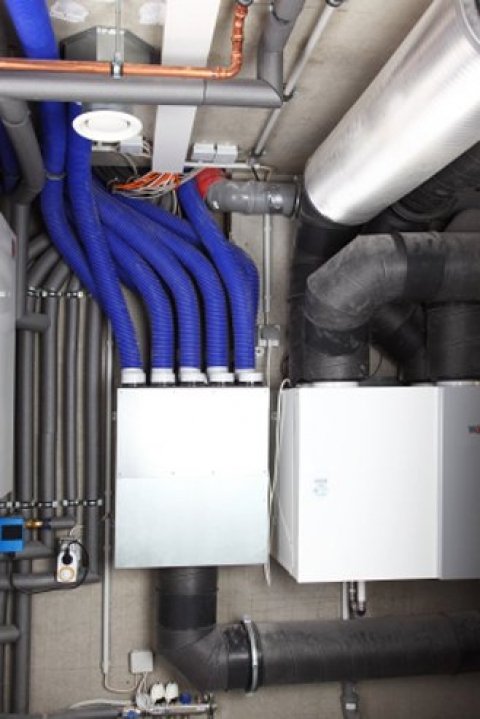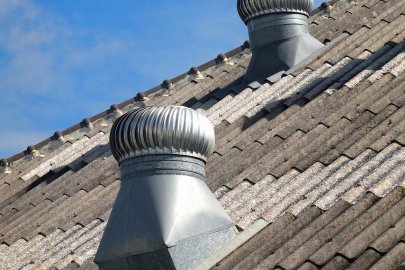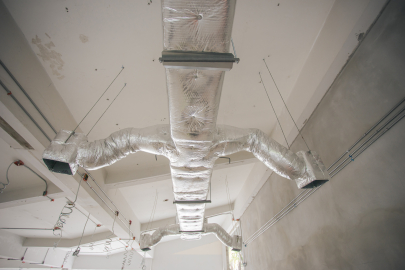Energy-efficient homes -- both new and existing -- require mechanical ventilation to maintain indoor air quality. There are four basic mechanical whole-house ventilation systems -- exhaust, supply, balanced, and energy recovery.
Comparison of Whole-House Ventilation Systems
| Ventilation System | Pros | Cons |
| Exhaust |
|
|
| Supply |
|
|
| Balanced |
|
|
| Energy Recovery & Heat Recovery Ventilators |
|
|
Exhaust Ventilation Systems
Exhaust ventilation systems work by depressurizing your home. The system exhausts air from the house while make-up air infiltrates through leaks in the building shell and through intentional, passive vents.

Exhaust ventilation systems are most appropriate for cold climates. In climates with warm humid summers, depressurization can draw moist air into building wall cavities, where it may condense and cause moisture damage.
Exhaust ventilation systems are relatively simple and inexpensive to install. Typically, an exhaust ventilation system consists of a single fan connected to a centrally located, single exhaust point in the house. A better design is to connect the fan to ducts from several rooms, preferably rooms where pollutants are generated, such as bathrooms. Adjustable, passive vents through windows or walls can be installed in other rooms to introduce fresh air rather than rely on leaks in the building envelope. Passive vents may, however, require larger pressure differences than those induced by the ventilation fan to work properly.
One concern with exhaust ventilation systems is that -- along with fresh air -- they may draw in pollutants, including:
- Radon and molds from a crawlspace
- Dust from an attic
- Fumes from an attached garage
- Flue gases from a fireplace or fossil-fuel-fired water heater and furnace.
These pollutants are a particular concern when bath fans, range fans, and clothes dryers (which also depressurize the home while they operate) are run when an exhaust ventilation system is also operating.
Exhaust ventilation systems can also contribute to higher heating and cooling costs compared with This was an empty link: energy recovery ventilation systems energy recovery ventilation systems because exhaust systems do not temper or remove moisture from the make-up air before it enters the house.
Supply Ventilation Systems
Supply ventilation systems use a fan to pressurize your home, forcing outside air into the building while air leaks out of the building through holes in the shell, bath, and range fan ducts, and intentional vents (if any exist).

Like exhaust ventilation systems, supply ventilation systems are relatively simple and inexpensive to install. A typical supply ventilation system has a fan and duct system that introduces fresh air into usually one -- but preferably several -- rooms that residents occupy most (e.g., bedrooms, living room). This system may include adjustable window or wall vents in other rooms.
Supply ventilation systems allow better control of the air that enters the house than exhaust ventilation systems do. By pressurizing the house, supply ventilation systems minimize outdoor pollutants in the living space and prevent backdrafting of combustion gases from fireplaces and appliances. Supply ventilation also allows outdoor air introduced into the house to be filtered to remove pollen and dust or dehumidified to provide humidity control
Supply ventilation systems work best in hot or mixed climates. Because they pressurize the house, these systems have the potential to cause moisture problems in cold climates. In winter, the supply ventilation system causes warm interior air to leak through random openings in the exterior wall and ceiling. If the interior air is humid enough, moisture may condense in the attic or cold outer parts of the exterior wall, resulting in mold, mildew, and decay.
Like exhaust ventilation systems, supply ventilation systems do not temper or remove moisture from the make-up air before it enters the house. Thus, they may contribute to higher heating and cooling costs compared with This was an empty link: energy recovery ventilation systemsenergy recovery ventilation systems. Because air is introduced into the house at discrete locations, outdoor air may need to be mixed with indoor air before delivery to avoid cold air drafts in the winter. An in-line duct heater is another option, but increases operating costs.
Balanced Ventilation Systems
Balanced ventilation systems, if properly designed and installed, neither pressurize nor depressurize your home. Rather, they introduce and exhaust approximately equal quantities of fresh outside air and polluted inside air.

A balanced ventilation system usually has two fans and two duct systems. Fresh air supply and exhaust vents can be installed in every room, but a typical balanced ventilation system is designed to supply fresh air to bedrooms and living rooms where occupants spend the most time. It also exhausts air from rooms where moisture and pollutants are most often generated (kitchen, bathrooms, and perhaps the laundry room).
Some designs use a single-point exhaust. Because they directly supply outside air, balanced systems allow the use of filters to remove dust and pollen from outside air before introducing it into the house.
Balanced ventilation systems are appropriate for all climates. Because they require two duct and fan systems, however, balanced ventilation systems are usually more expensive to install and operate than supply or exhaust systems.
Like both supply and exhaust systems, balanced ventilation systems do not temper or remove moisture from the make-up air before it enters the house. Therefore, they may contribute to higher heating and cooling costs, unlike energy recovery ventilation systems. Also, like supply ventilation systems, outdoor air may need to be mixed with indoor air before delivery to avoid cold air drafts in the winter.
Energy Recovery Ventilation Systems
Energy recovery ventilation systems provide a controlled way of ventilating a home while minimizing energy loss. They reduce the costs of heating ventilated air in the winter by transferring heat from the warm inside exhaust air to the fresh (but cold) outside supply air. In the summer, the inside air cools the warmer supply air to reduce cooling costs.
There are two types of energy-recovery systems: heat-recovery ventilators (HRV) and energy-recovery (or enthalpy-recovery) ventilators (ERV). Both types include a heat exchanger, one or more fans to push air through the machine, and controls. There are some small wall- or window-mounted models, but the majority are central, whole-house ventilation systems with their own duct system or shared ductwork.
The main difference between a heat-recovery and an energy-recovery ventilator is the way the heat exchanger works. With an energy-recovery ventilator, the heat exchanger transfers a certain amount of water vapor along with heat energy, while a heat-recovery ventilator only transfers heat.
Because an energy-recovery ventilator transfers some of the moisture from the exhaust air to the usually less humid incoming winter air, the humidity of the house air stays more constant. This also keeps the heat exchanger core warmer, minimizing problems with freezing.
In the summer, an energy-recovery ventilator may help to control humidity in the house by transferring some of the water vapor in the incoming air to the theoretically drier air that's leaving the house. If you use an air conditioner, an energy-recovery ventilator generally offers better humidity control than a heat-recovery system. However, there's some controversy about using ventilation systems at all during humid, but not overly hot, summer weather. Some experts suggest that it is better to turn the system off in very humid weather to keep indoor humidity levels low. You can also set up the system so that it only runs when the air conditioning system is running, or use pre-cooling coils.
Most energy recovery ventilation systems can recover about 70% to 80% of the energy in the exiting air and deliver that energy to the incoming air. However, they are most cost-effective in climates with extreme winters or summers, and where fuel costs are high. In mild climates, the cost of the additional electricity consumed by the system fans may exceed the energy savings from not having to condition the supply air.
Energy recovery ventilation systems usually cost more to install than other ventilation systems. In general, simplicity is key to a cost-effective installation. To save on installation costs, many systems share existing ductwork. Complex systems are not only more expensive to install, but they are generally more maintenance intensive and often consume more electric power. For most houses, attempting to recover all of the energy in the exhaust air will probably not be worth the additional cost. Also, these types of ventilation systems are still not very common. Only some HVAC contractors have enough technical expertise and experience to install them.
In general, you want to have a supply and return duct for each bedroom and for each common living area. Duct runs should be as short and straight as possible. The correct size duct is necessary to minimize pressure drops in the system and thus improve performance. Insulate ducts located in unheated spaces, and seal all joints with duct mastic (never ordinary duct tape).
Also, energy recovery ventilation systems operated in cold climates must have devices to help prevent freezing and frost formation. Very cold supply air can cause frost formation in the heat exchanger, which can damage it. Frost buildup also reduces ventilation effectiveness.
Energy recovery ventilation systems require more maintenance than other ventilation systems. They need to be cleaned regularly to prevent deterioration of ventilation rates and heat recovery and to prevent mold and bacteria on heat exchanger surfaces.
Subscribe to receive updates from Energy Saver, including new blogs, updated content, and seasonal energy saving tips for consumers and homeowners.





